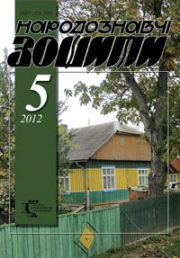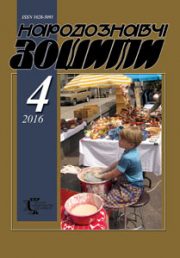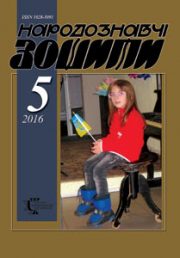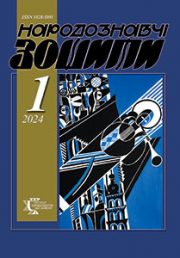The Ethnology Notebooks. 2019, № 6 (150), 1464—1481
UDK73.04.03(477)”194″:271.4-726.2″15/16″Св.СВМЧ. Й.Кунцевич
DOI https://doi.org/10.15407/nz2019.06.1464
SEMCHYSHYN-HUZNER Olesia
ORCID ID: https://orcid.org/0000-0001-9677-995X
Сandidate of Arts (Ph. D),
Senior Researcher,
The Andrey Sheptytsky National Museum in Lviv,
Department of Ukrainian Art of the ХІХ—ХХ Centuries,
20, Svobody Avenue, 79008, Lviv, Ukraine
e-mail: olesiasem17@gmail.com
Abstract. Introduction and Problem Statement Josaphat Kuntsevych (1580—1623) is a Catholic Saint, the Bishop of Polotsk, protector and first saint of the Uniate Church, one of the patrons of OSBM. The portrait of St. Josaphat in the Ukrainian art of the early 20th century as exemplified by the works of such artists as: M. Sosenko, A. Manastyrskyi, P. Kholodnyi, Yu. Mahalevskyi etc., is not covered nowadays in the literature as a self-consistent phenomenon, however, some artistic representations found at those times were so successful that their popularity grows with the years and crosses the boundaries and confessional prejudices which forms the topicality of the suggested research.
The Purpose is to clarify the reasons of the artists’ reference to the personality of St. Josaphat during the stated period, trace the changes in the formation of his image, determine the degree of dependence of monuments both upon the iconography of the Saint of the 17th—19th centuries and upon the modern phenomena. Object of the research is the images of St. Josaphat performed by the Ukrainian artists. Subject of the research is the iconography of St. Josaphat.
Method. The article employs the comparative method to clarify the connection between the historical events and changes in the iconography of the saint, as to the work with the monuments, description, artistic analysis, systematization and generalization methods were also very helpful.
Results. The appearance of quite substantial amount of the portraits of St. Josaphat in the Ukrainian art of the 20th century, as compared to the previous century, is explained by the renovation of the Basilians Order. Also by the active position in the dissemination of the cult of Martyr by A. Sheptytskyi, Leader of the Greek Catholic Church and J. Slipyi, Rector of the Theological Seminary. Monuments of that period are characterized by the variation of iconography which depended upon many factors. Outlining three stages demonstrating the peculiarities of worshiping the Saint: before the World War I, the 1920s and the 1930s. During these periods two iconographic traits coexist: the first one developed as based on the samples of the 19th century, the other one demonstrates the new portraits of the Saint with a wide conceptual context, the images of the Saint, which were much influenced by the historical events of those times.
Conclusion Iconography of St. Josaphat Kuntsevych in the Ukrainian art of the early 20th century is a unique phenomenon, bright in its diversity and conceptual richness. The image advancement takes place i. e. from the closed one as a Martyr for the Faith to the broad-scaled, as a Nationwide Saint.
Keywords: St. Martyr Josaphat Kuntsevych, iconography, Ukrainian art of the early 20th century, Uniate Church, Ukrainian Saint.
Received 21.11.2019
REFERENCES
Shchurat, V. (1923). The oldest images and handwriting of St. Martyr Josaphat Kuntsevych. Bohosloviia, (Vol. І, b. 3—4, pp. 195—206) [in Ukrainian].
Botsian, Y., р. (1924). Georg Hofmann S.J., Prof. Der orient. Kirchengeschichte im. Pдpstl. Institut. St. Josaphat, the Archbishop of Polotsk and Martyr. Selected Resources. I. Studying the Origin of St. Josaphat. Roma: Pontificio Istituto Orientale. «Orientalia Christiana» (Vol. 1 (1923), pp. 297—320); Bohosloviia (Vol. ІІ, b. 1, pp. 58—61) [in Ukrainian].
Solovey, M.M, & Welykyi, A.G. (1967). Saint Josaphat Kuncevich. His life and his time. Toronto: Basilian press [in Ukrainian].
Sydor, O. (1999). Saints Patrons of basilian fathers’. Halytska brama, 1—2 (49—50), 14—16 [in Ukrainian].
Zilinko, R. (2012). An overview of the iconography of St. Josafat Kuntsevych (on the example of works from the National Museum in Lviv collection). Apolohet, 32—33 (Proceedings of the V International Scientific Conference: Christian Sacred Tradition: Faith, Spirituality, Art). Lviv [in Ukrainian].
Јepkowski, M., Betlej, A., & Skrabski, J. (Eds.). (2008). The earliest portraits of St. Josaphat Kuntsevych and the issue vera effigies in the Formation of the Saints Iconography after the Council of Trent. In Fides. Ars. Scientia. Studia dedykowane pamiкci Ksiкdza Kanonika Augustyna Mednisa (Pp. 310—311). Tarnуw [in Polish].
Susza, J. (1665). Cursus vitae et certamen martyrii, B. Iosaphat kuncevicii Archiepiscopi Poloceс. Episcopi Vitepsceс. & Miscislauieс. Ord. D. Basilij Magni. Roma, Ex Nypographia Varesij. MDCLXV [in Latin].
Gil, A. (Ed.). (2005). The Cult of Josaphat Kuntsevych and His First Iconic Portraits in Rzeczpospolita (by the mid 17th century). In Zarys problematyki. Koњcioіy wschodnie w Rzeczypospolitej XVI—XVIII wieku: Zbiуr studiуw (pp. 65—72). Lublin [in Polish].
Gil, A., & Bobryk, W. (Eds.). (2010). The First Images and the Beginning of the Cult of the Archbishop of Poіock Josaphat Kuncewicz in the Polish-Lituanian Commonwealth till the mid —17th Century. In On the Border of the Worlds. Essays about the Orthodox and Uniate Churches in Eastern Europe in the Middle Ages and the Modern Period (Pp. 147—169). Lublin [in Polish].
Gil, A. (2011). Did the portrait of Josaphat Kuntsevych, the Archbishop of Polotsk, really exist? Volynska ikona: doslidzhennia ta restavratsiia (Vol. 18). (Proceedings of the ХVIII International Scientific Conference). Lutsk [in Polish].
Kreuza, L. (1625, 17 January). The Sermon on the Life and Glorious Death of the Reverend Father Josaphat Kuntsevych, the Archbishop of Polotsk, Vitebsk and Mstislav at the Polotsk Cathedral was delivered over his body by Leon Krevza, Nominee to the Office of Bishop of Smolensk (translated from ukrainian) [in Polish].
Guйpin, A., p. Dom. (1874). St. Josaphat, the Archbishop of Polotsk, Martyr of the Catholic Union and Uniate Greek Church in Poland (Vol. 1). Paris: Chez Victor Palmй [in France].
Guйpin, A., p. (1897). Church Union of the 17th century. St. Josaphat and the Greek Slavonic Church in Poland and Russia (Vol. 1). Paris [in France].
Guйpin, A., o. (1885). Curriculum Vitae of St. Josaphat Kuntsevych, Martyr, Archbishop of Polotsk was Narrated against the Background of the History of the Rus Church with the foreword by H. Kalinka. Lwуw: nakіadem ksiкgarni Gubrynowicza i Schmidta [in Polish].
Guйpin, A., o. (1908). Curriculum Vitae of St. Josaphat Kuntsevych, Martyr, Archbishop of Polotsk was Narrated against the Background of the History of the Rus Church with the foreword by H. Kalinka. Lwуw: nakіadem ksiкgarni Gubrynowicza i Schmidta [in Polish].
Svientsitskyi, I. (1920). Modest Sosenko (1875—1920). Exibitions’ catalog [in Ukrainian].
Holubets, M. (1925). 100 years of Galician painting. 1804—1904. Stara Ukraina, (Part VII—X, p. 150) [in Ukrainian].
Botsian, Y., р. (1923). Finding and recognizing the relics of St. Martyr Josaphat Kuntsevich 1915—1917. Bohosloviia (Vol. І, b. 3—4, pp. 284—318) [in Ukrainian].
Sydor, O. (2012). Patriarch Yosyph Slipyi and art. Kyiv-Rym: Relihiine tovarystvo «Sviata Sofiia» dlia ukraintsiv katolykiv [in Ukrainian].
Slipyi, Yosyph, Datsko, I., & Horiacha, M. (2 eds.). (2014). Memories. Lviv; Rome: Vydavnytstvo UKU [in Ukrainian].
Slipyi, Y. (1925). Holy Martyr Josaphat Kuntsevich: Materials and intelligences on the occasion of the anniversary. Lviv [in Ukrainian].
(1922). The Great Anniversary of 1623—1923 (the three hundredth anniversary of the martyrdom of St. Josaphat). Kaliendar Misionaria na rik 1923 (Pp. 81—116). Zhovkva [in Ukrainian].
Skr., Y. (1923). In Volodymyr-Volynskii. (Some memories). Kaliendar Misionaria na rik 1924 (Pp. 102—103). Zhovkva [in Ukrainian].
(1923). Native holiday. Kaliendar Misionaria na rik 1924 (Pp. 35—41). Zhovkva [in Ukrainian].
(1925). In literature and art. P. Kholodnyi’s new picture. Tryzub (Part 9, p. 30) [in Ukrainian].
Ostroverkha, M. (1937). New stained glass by P. Kholodnyi-father. Nazustrich (Part 1, p. 1) [in Ukrainian].
Batih, M. (2005). Painter Yurii Mahalevskyi. Halytska brama, 1—3 (121—123), 32—35 [in Ukrainian].
Bilan, I. (2013). Church painting of Yury Mahalevsky. Visnyk Kharkivs’ koji Derzavnoji Academiji Dyzajnu i Mystectv, 8, 48—56 [in Ukrainian].
Kuchabskyi, V., p. (1937). The First Greek Catholic Congress in Lviv. December 22—25, 1936 with the participation of Basilians, Redemptorists and Studite. Bohosloviia (Vol. ХV, b. 1—4, pp. 35—44) [in Ukrainian].
Razinkova, L. (2007). The revival of Y. Mahalevsky’s work. Biuleten Lvivskoho filialu NDRTs Ukrainy, 1 (9), 130—131 [in Ukrainian].
Hakh, I., Sydor, O. (2006). Yulian Butsmanyuk. Wall painting of Christ the Lover of mankind church in Zhovkva. Lviv: basilian fathers’ publishing house «Missioner» [in Ukrainian].
(1929—1938). The Central State Historical Archive of Ukraine in Lviv (TsDIAU, L’viv). F. 201 (Mytropolycha hreko-katolytska konsystoriia u Lvovi). Op. 1б. Od. zb. 5760 (Materyaly ob ymushchestvennom sostoianyy prykhoda Kholoev Kamianko-Strumylovskoho dekanata (1929—1938) (Ark. 4—98).
(1933). Wall painting of church in Zhovkva. Misionar (Part 3, p. 61) [in Ukrainian].







